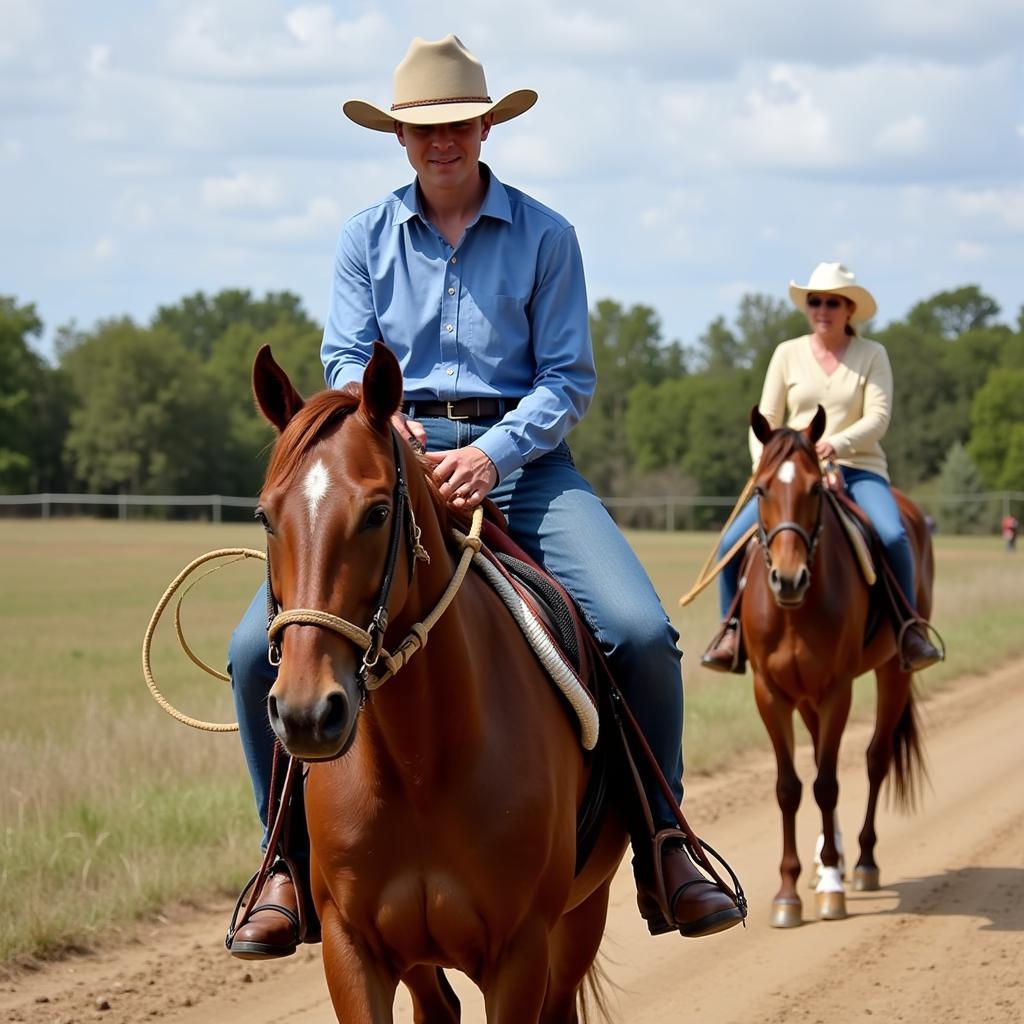Rope reins are becoming increasingly popular among horse owners and riders of various disciplines. They offer a different feel and level of communication compared to traditional leather reins, which can be beneficial for both horse and rider. This comprehensive guide will delve into everything you need to know about Rope Reins For Horses, from their advantages and potential drawbacks to choosing the right type and using them safely and effectively.
 Rope reins on a horse
Rope reins on a horse
Understanding Rope Reins
Rope reins are typically made from a single or braided strand of durable material, often nylon or a blend of synthetic fibers. Unlike leather reins with buckles, rope reins feature knots or stopps that provide grip and allow for adjustments in length. The lightweight and flexible nature of rope reins makes them highly responsive to subtle cues, allowing for precise communication between horse and rider.
Advantages of Using Rope Reins
Enhanced Communication
The direct connection and lack of bulk with rope reins translate to clearer signals being sent to the horse. This enhanced sensitivity can improve responsiveness and refine cues for various maneuvers.
Lightweight and Comfortable
The lightweight design reduces strain on both horse and rider, particularly during long rides. The soft texture of the rope can also be more comfortable for horses with sensitive mouths.
Durable and Long-lasting
Rope reins are highly resistant to wear and tear, making them a durable and long-lasting investment. They are less likely to break under pressure compared to some leather reins.
Versatility in Disciplines
Rope reins are suitable for a variety of riding disciplines, from western riding and trail riding to English disciplines and even driving. Their versatility and adaptability make them a popular choice for riders of different backgrounds.
Considerations and Potential Drawbacks
Learning Curve
Using rope reins effectively requires a different feel and timing compared to traditional reins. It may take some time for both horse and rider to adjust to this new form of communication.
Potential for Rope Burns
Improper handling or sudden jerks on rope reins can lead to rope burns, especially for the rider. It’s crucial to use them with finesse and avoid harsh movements.
Knots and Adjustments
While the adjustable knots on rope reins offer flexibility, they may loosen over time and require readjustment. Regular checks and proper knot tying techniques are essential.
Choosing the Right Rope Reins
Material and Braiding
Rope reins are available in various materials like nylon, polypro, and biothane. Consider factors like durability, grip, and feel when choosing the material. Different braiding patterns can also affect the reins’ flexibility and handling.
Length and Diameter
Rope reins come in different lengths to suit different riding styles and horse sizes. The diameter of the rope can also influence grip and feel.
Knots and Stopps
The type and spacing of knots on rope reins affect adjustability and grip. Some reins feature leather stopps for added durability and a traditional look.
 Horse and rider using rope reins effectively
Horse and rider using rope reins effectively
Using Rope Reins Safely and Effectively
- Gradual Introduction: Introduce rope reins gradually to your horse, allowing them to get accustomed to the feel and responsiveness.
- Proper Hand Position: Maintain a soft and consistent feel on the reins, avoiding harsh jerks or pulling.
- Smooth Transitions: Practice smooth transitions and cues to avoid confusion and potential discomfort for your horse.
- Regular Inspections: Regularly inspect your rope reins for any signs of wear and tear and replace them when necessary.
Rope reins, when used correctly, can enhance communication and partnership between horse and rider. By understanding the benefits, considerations, and proper techniques, you can make an informed decision about incorporating rope reins into your riding.
FAQs about Rope Reins for Horses
Are rope reins suitable for beginners?
While rope reins can be used by riders of all levels, they require a certain level of finesse and experience. Beginners should seek guidance from an experienced trainer before transitioning to rope reins.
Can I use rope reins with a bitless bridle?
Yes, rope reins can be used with both bitted and bitless bridles. The choice depends on your horse’s training and your riding preferences.
How do I clean and care for my rope reins?
Rope reins are relatively low-maintenance. They can be cleaned with mild soap and water and hung to dry. Avoid using harsh chemicals or leaving them exposed to prolonged sunlight.
What is the average lifespan of rope reins?
The lifespan of rope reins depends on usage, care, and quality. With proper maintenance, they can last for several years.
Where can I find reputable sources for purchasing rope reins?
You can find rope reins at reputable tack shops, online retailers specializing in biothane horse tack, and from experienced rope makers.
Need More Help with Your Horse?
For more information on horse care, training, and equipment, browse our website for articles on snaffle horse bits, horse dragging, and martingale horse tack. You can also find a great selection of horse riding clothes womens.
Have questions about rope reins or any other horse-related topic? Contact Justus Horses USA at 0772127271 or [email protected]. Our team of experts is available 24/7 to assist you. We are located at QGM2+WX2, Vị Trung, Vị Thuỷ, Hậu Giang, Việt Nam.